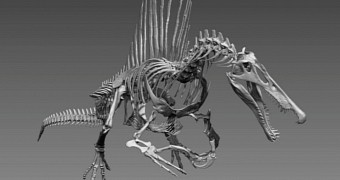In a paper published in the journal Science this September 11, paleontologists argue that, according to evidence at hand, a dinosaur that inhabited the Earth about 97 million years ago was well adapted to living and hunting in water.
This ancient beast, whose skeleton is reconstructed in the image accompanying this article, looked very much like the love child of a duck and a crocodile would. It was larger than your average T. rex, and its back had bony spikes sticking out of it.
Not exactly a new species
As detailed in the journal Science, fossilized remains left behind by one such ancient aquatic predator were discovered several decades ago in Egypt by a German paleontologist by the name of Ernst Stromer, who described them in a paper published in 1915.
Unfortunately, the fossils were destroyed when the Allied Royal Air Force bombed Munich in 1944. It was not until the 21st century that the scientific community came across a skeleton that was well preserved enough to allow them to study the creature.
This second set of fossilized remains was recovered from the Moroccan Sahara. Together with photos and other bones kept at museums around the world, the freshly unearthed fossils made it possible for scientists to gain a better understanding of this species, now known as Spinosaurus aegyptiacus.
Anatomical quirks
While analyzing the remains found in the Moroccan Sahara, researchers with the University of Chicago in the US and colleagues noticed that, unlike other dinosaur bones discovered and studied over the years, these had a hollow cavity at the center.
As explained in the journal Science, such cavities are fairly common among marine mammals, which rely on them as a means of buoyancy control. Eventually, specialists managed to create a digital model of the animal, and found that it was perfectly adapted to populating aquatic environments.
They found that Spinosaurus aegyptiacus had crocodile-like teeth, a flexible tail similar to a rudder, small hind limbs, and flat feet resembling paddles. Besides, its nostrils were located high on his head, in the middle of its snout. This anatomical particularity can also be observed in modern crocodiles.
All in all, this ancient beast is estimated to have measured about 50 feet (over 15 meters) in length, and to have tipped the scale at about 44,000 pounds (nearly 19,960 kilograms). Despite its impressive size, paleontologists suspect that it fed not on other massive animals, but on fish.
“In the last two decades, several finds demonstrated that certain dinosaurs gave origins to birds. Spinosaurus represents an equally bizarre evolutionary process, revealing that predatory dinosaurs adapted to a semi-aquatic life and invaded river systems in Cretaceous North Africa,” specialist Cristiano Dal Sasso commented on these findings.
“You would not want to meet this animal on land, but it was not gallivanting across the landscape. It's a chimera. It's half-duck, half-crocodile. We don't have anything alive that looks like this animal,” added vertebrate paleontologist Paul Sereno.

 14 DAY TRIAL //
14 DAY TRIAL //